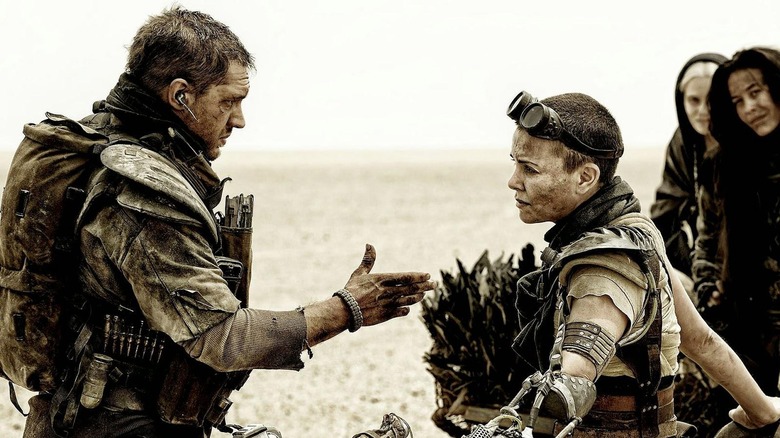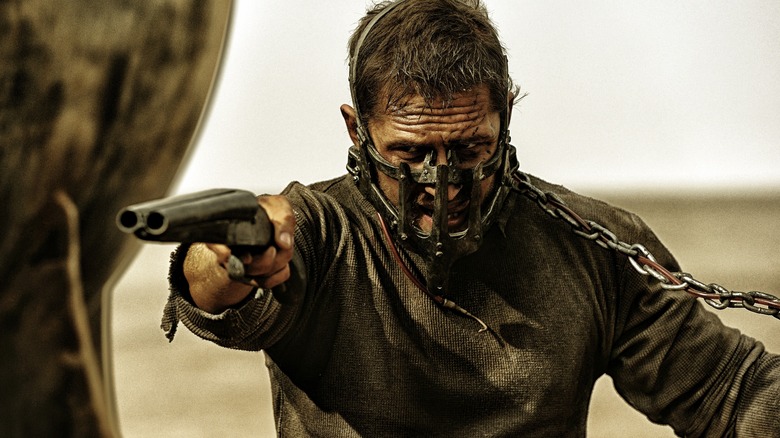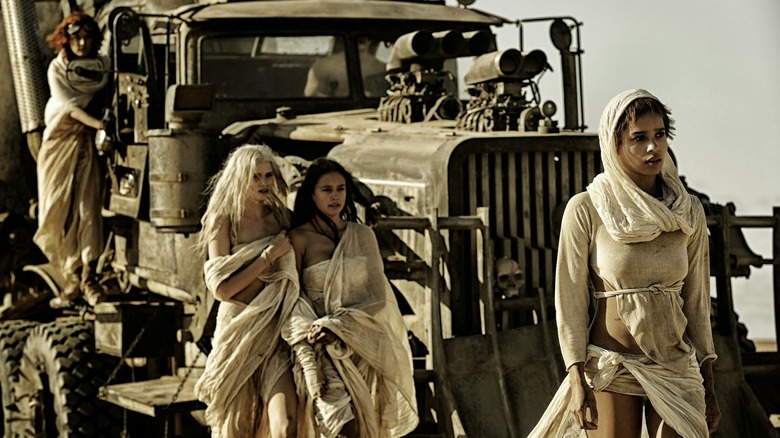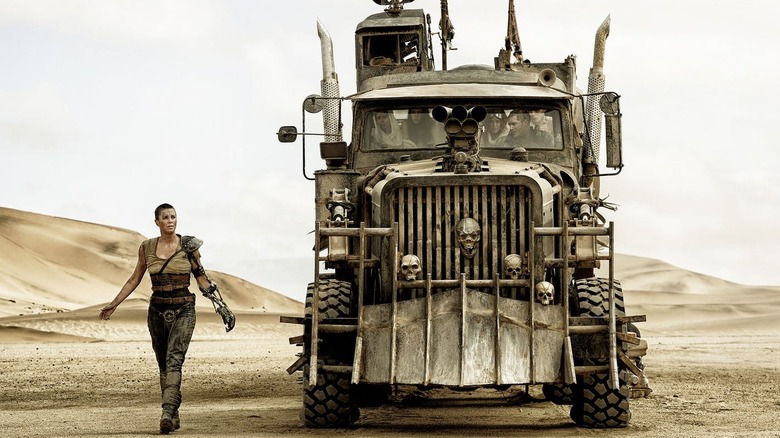Fate Seemed Determined To Keep Mad Max: Fury Road Trapped In Development Hell
Equal parts oil-slicked, dusty post-apocalyptic chase thriller, and half-forgotten ancient myth, "Mad Max: Fury Road" opened to enormous critical acclaim in 2015, and was quickly canonized into the action film firmament by its many fans. The film follows Max (Tom Hardy) as he is kidnapped by an evil car-obsessed cult led by a villainous harem-keeper, and who then becomes involved in a scheme by the heroic Furiosa (Charlize Theron) to rescue the harem-keeper's wives.
Although considered something of a box office disappointment at the time (it opened at #2 behind the musical college comedy "Pitch Perfect 2"), it went on to be considered for multiple awards, including Best Picture and Best Director at the Academy Awards. It won Oscars for its editing, costumes, makeup, production design and sound mixing. It has played the midnight circuit in certain cities, and is often considered by pundits and fans as the best film in the series.
Directed by George Miller, helmer of the previous three films in the series, "Fury Road" was only released in 2015 after what had proven to be a over a decade of development hell. The previous film in the "Mad Max" series, "Mad Max: Beyond Thunderdome" was released way back in 1985, and the road to "Fury Road" was a long, circuitous, and incredibly difficult one. Production was to be halted throughout the years by shifting financials, war, the bad behavior of the film's intended star, and unexpectedly good weather.
In an oral history published by The New York Times in 2020, the cast and crew went over all the minutiae that prevented "Mad Max: Fury Road" from coming to the big screen, and what finally needed to happen to complete it.
Genesis
Following the release of "Beyond Thunderdome," Miller was willing to put the "Mad Max" series to rest. The post-apocalypse he envisioned with "Mad Max," "The Road Warrior," and "Thunderdome" was, he felt thoroughly explored, and nothing more needed to be said. There was demand from fans to make a fourth film since the release of the third, so the series was always in his mind. Miller says that, while crossing a street in L.A. one day, he struck upon the idea to make a "Mad Max" film that was essentially one long chase, with a human being as the McGuffin. The iron was once again hot.
This was in the late-1990s, and Miller and his producer Doug Mitchell began shopping the idea around. Uma Thurman was asked to star at one point, with Mel Gibson set to return to the role of Max, which he had played in the previous three films. Miller was to make the film for Fox, and shooting was initially scheduled to begin in a few years' time, in Namibia in March of 2003.
The first major setback, however, was 9/11. Thanks to the events of that day, studios became incredibly skittish with their money, and were spending a lot more cautiously all of a sudden. The pre-production on "Fury Road" was halted, leaving much of the crew high and dry. The film's production designer Colin Gibson (no relation to Mel) recalls being in Namibia, in the middle of building the many elaborate cars and vehicles that were to be the centerpiece of "Fury Road," when he received the call from the studio to stop working. Gibson admitted that he figured the studio wanted to give their money elsewhere, but no explanation was given.
Colin Gibson also reported getting a nervous e-mail from Mel Gibson's wife, who had been struck by a bolt of Islamophobic paranoia, worried that Mel Gibson might me in danger if he traveled to Namibia. (For the record, about 90% of the people in Namibia identify as Christian.) With production halted, George Miller shifted his focus to the animated film "Happy Feet," which would be released in 2006, and which would win Miller an Academy Award. "Fury Road" was to commence production soon thereafter.
Mel Gibson's bad behavior
In 2006, however, Mel Gibson would be arrested for a DUI (Gibson wrestled with alcoholism for decades), and would also be caught on record making anti-Semitic comments and sexual language to a cop. These anti-Semitic comments accentuated Gibson's own depiction of certain Jewish characters in his 2003 film "The Passion of the Christ." Many members of the public became aware of Gibson's ultraconservative views, and his comments in 2006 were proof positive of his lasting bigotry. Because of this event, not to mention the fact that Gibson was already in his 50s, Miller elected not to have the actor back as Mad Max, and auditions were held for a new leading man.
After reworking the entire production, Miller finally settled on an Australian shoot in 2010. Tom Hardy had been cast as Max (although Jeremy Renner was in serious consideration), with Charlize Theron remaining on board, as she had already been a part of the production. Theron was, she admits, a big fan of the "Mad Max" movies, having watched them as a girl in South Africa.
With the cast finally in place, and Australian shooting locations secured ("Fury Road" was to be filmed in Broken Hill where Miller shot the first two films), everything was set to go. Until nice weather ruined everything again.
Too many flowers
Two weeks before shooting down under, the skies opened up, and a once-in-a-century downpour covered Queensland. The crew reported that they had never seen that kind of rain before. Following the rains, flowers began blooming all over the landscape — a symbol of hope and beauty that was the exact opposite of the dried wasteland that Miller wanted to film. After two weeks of unfortunately clement weather, the production was shut down entirely.
Miller, however, had become determined. He was not going to give up on "Fury Road." He suggested everyone wait a year to see if the desert dries up, and that they simply try again. While waiting, Miller grew impatient, and the production moved (again) back to Namibia. By July of 2012, principal photography finally began after nine years of bad luck and false starts.
They weren't out of the weeds just yet, however. Because "Mad Max: Fury Road" involved so many cars and hot rods and trucks and other elaborate vehicles, the Namibian Coast Conservation and Management Project (NACOMA) became concerned that the local ecosystem was being torn up by all the tires and smoke on the set. After representatives were allowed to visit the set, all concerns were laid to rest. Miller was filming responsibly and was not doing any kind of undue damage to the local environment.
Shooting on "Mad Max: Fury Road" wrapped in December of 2013, and the film was released in 2015.
"Fury Road" had a dramatic path to the big screen, but it's important to remind readers that very few big-budget studio pictures have a clear path from the start. Problems and complications are going to arise on the set of any film, and last-minute changes need to be made constantly. Reshoots are common, as are mid-production rewrites that either clarify story or character moments or that just make for a cleaner narrative. "Mad Max: Fury Road" had a far more difficult than average production, of course, but, as history has proven out, sometimes the wait is worth it.



